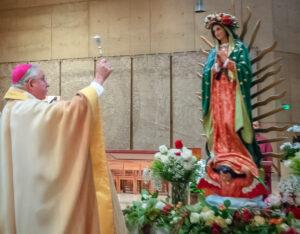By Bishop Joseph M. Siegel
The Message publisher
Editor's note: This event will be livestreamed on the St. Benedict Cathedral Facebook page. Click here to watch.

CNS photo by Victor Aleman, Angelus News
At 2 p.m. CDT (3 p.m. EDT) on Friday May 1, at St. Benedict Cathedral, I will be joining the Bishops of the United States in re-consecrating our nation to the Blessed Virgin Mary. The event will coincide with the Bishops of Canada consecrating their own country to Our Lady at the same time. This is being done at the invitation of Archbishop José Gomez of Los Angeles, President of the United States Conference of Catholic Bishops. While May is always dedicated to Mary, the Archbishop has asked for this special re-consecration in response to the COVID-19 global pandemic.
This Marian re-consecration will be done under the title of “Mary, Mother of the Church.” Over the years, our country has been consecrated to our Blessed Mother under various titles. The title “Mother of the Church” has its roots on Calvary as Jesus, hanging on His cross, gave Mary to the beloved disciple as his own mother (John 19:27). This beloved disciple has traditionally been viewed as personifying all disciples of Christ, i.e. the Church. Further, the Acts of the Apostles places Mary in the upper room with the apostles on the day of Pentecost when the descent of the Holy Spirit gave birth to the Church.
St. Ambrose of Milan in the 4th century was the first to use this title for Mary. His protégé, St. Augustine, wrote, “She (Mary) is the mother of the members of Christ because she cooperated by her charity, so that faithful Christians, members of the Head (Christ), might be born into the Church.” In the 5th century, St. Leo the Great, in one of his Christmas sermons, wrote, “The birth of the Head is also the birth of the body,” explaining that Mary, as Mother of the Son of God, is also mother of the members of his Mystical Body, the Church.
Pope St. Paul VI, who had been a successor of St. Ambrose as archbishop of Milan, officially gave Mary this title as he closed the third session of the Second Vatican Council on Nov. 21, 1964. He declared: "For the glory of the Virgin and our consolation, we proclaim Mary the Most Holy Mother of the Church; that is, the Mother of the whole People of God, both the faithful and the pastors." He also added a votive Mass of Mary, Mother of the Church, to the Roman Missal. Pope St. John Paul II also had great appreciation for this title, using it in his 1987 encyclical Redemptoris Mater. He wrote:
“Mary is present in the Church as the Mother of Christ, and at the same time as that Mother whom Christ, in the mystery of the Redemption, gave to humanity in the person of the Apostle John. Thus, in her new motherhood in the Spirit, Mary embraces each and every one in the Church, and embraces each and every one through the Church. In this sense Mary, Mother of the Church, is also the Church's model. Indeed, as Paul VI hopes and asks, the Church must draw ‘from the Virgin Mother of God the most authentic form of perfect imitation of Christ.’”
St. John Paul II would also add this title to the Litany of Loreto, install a mosaic of Mater Ecclesiae (Mother of the Church) in St. Peter’s Square and found a monastery in the Vatican with this title. Pope Emeritus Benedict XVI, who currently lives in this monastery, wrote of this title, “The Church is virgin and mother; she is immaculate and carries the burdens of history. She suffers and she is assumed into heaven. Slowly she learns, that Mary is her mirror, that she is a person in Mary. Mary on the other hand is not an isolated individual, who rests in herself. She is carrying the mystery of the Church.” Most recently, Pope Francis decreed in 2018 that the obligatory memorial of Mary, Mother of the Church, be added to the liturgical calendar and celebrated each year on the Monday after Pentecost.
So, as we continue to struggle under the cloud of this terrible health crisis, let us again entrust ourselves, our diocese, our nation and our world to the loving care and protection of Mary, Mother of the Church. May she intercede for us to her Son that we might be delivered from this pandemic and all its terrible effects.
